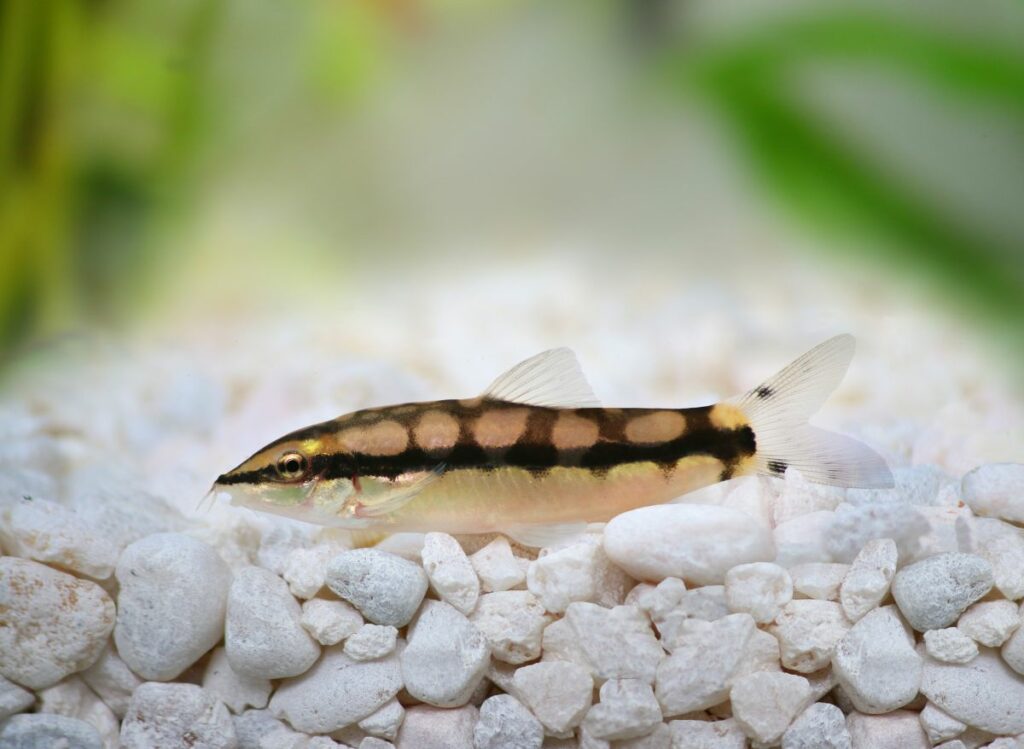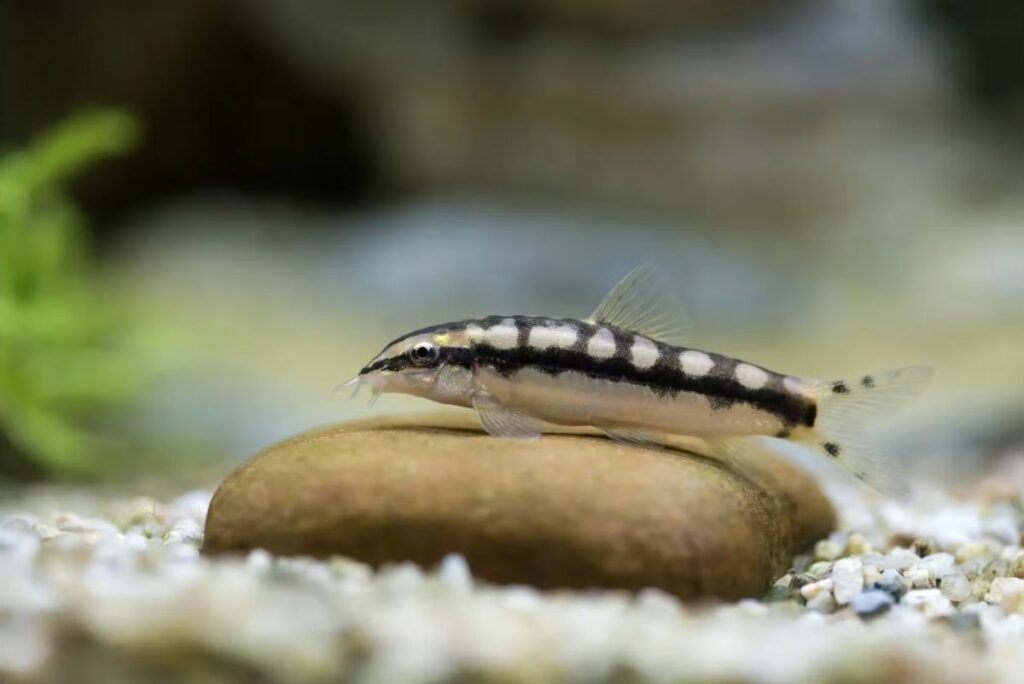The Dwarf Chain Loach is a small species of freshwater fish that is popular with nano and planted aquarium keepers. As active and outgoing as they are, they are bottom dwellers with personalities. Plus they do well in groups, eat anything, and have a bold, beautiful striped pattern.

My Dwarf Chain Loach care guide will take you on an in-depth exploration of caring for these unique little loaches. From tank size to feeding, no aspect of their care is left untouched.
What are Dwarf Chain Loaches?
The loach family has been a staple in the freshwater fish trade for decades. Dojo Loaches and Clown Loaches are the two most common species to see. But the third just might be the intriguing Dwarf Chain Loach.
Wild populations are found within the Mae Klong river basin of Thailand and a few surrounding areas. They prefer well-oxygenated water with a moderate current in their natural habitat.
The Dwarf Chain Loach has become more popular in recent years. Their striking black bars offer a strong contrast to green plants and rocks. And since they are not the same size as larger loach species you can house a large group in a smaller tank.
- Common Names: Dwarf Chain Loach, Dwarf Clown Loach, Dwarf Loach, Chain Loach
- Scientific Name: Ambastaia sidthimunki/Botia sidthimunki
- Origin: Thailand
- Length: 2.5 inches
- Aquarium Size: 20-30 gallons
- Temperament: Semi-aggressive fish
- Ease of Care: Easy
Dwarf Chain Loach Care
An aquarium full of live aquatic plants and a soft substrate will keep your loaches very happy. And if you have a few snails that are hard to get rid of, they will be a regular part of their diet.

Tank Setup for Dwarf Clown Loach
When choosing an aquarium for this active species we want to provide as much water volume as possible. A “long” style tank is preferable to a “high” since the loaches will race back and forth over a longer area.
Dwarf Chain Loach size is very manageable. A 20-gallon long is a good minimum for a group but 29-30 gallons is even more comfortable.
Smooth pebbles are an alternative to rough gravel. But fine sand is by far the best substrate choice for a Dwarf Chain Loach.
As scaleless fish, they have sensitive skin that’s not well protected. Also, Dwarf Chain Loaches enjoy burrowing to find worms, snails, and leftover food.
If they try burrowing into rough gravel this species run the risk of scratching their skin. These scratches will get infected by body fungus and other diseases. Fine-grained sand and smooth rocks are also gentler on their sensitive whiskers.
Water Conditions and Temperature
In their natural habitat, the Dwarf Chain Loach is always fighting against a moderate water current. So the fish are used to being extremely active. They dart around to find still patches of water and find food sources as they float by.
Current isn’t required but they do prefer it. The outflow of an aquarium filter should be set up to provide current and aeration. Or you can even set up a powerhead or wave maker to create constant, continual flow. Both options are ideal for adding extra oxygen to your tank water as well.
When it comes to tank parameters, the Dwarf Chain Loach prefers acidic to weak alkalinity (pH 6.0-7.5). Water hardness should be low and the water temperature should be between 73-80°F. That said, they accept a wide temperature range as low as 68°F and as high as 86°F without much stress.
If your Dwarf Chain Loach shows signs of ich or body fungus, raising the water temperature to 84-86°F will help since they are sensitive to skin issues.

Feeding Dwarf Chain Loaches
As true omnivores, a Dwarf Chain Loach needs to eat both plants and animals. In the wild, they feed on Ramshorn and other snails, shrimp, worms, insects, and other invertebrates.
If they find any fish eggs, baby fish, or other small items a Dwarf Chain Loach will eat them with gusto. They also nibble on algae, including green hair algae. And softer plants like Elodea and Cabomba. Strong plants like Anubias and Java Fern are bitter and not as tasty.
Therefore a varied diet is important to a Dwarf Chain Loach. Supplement any prepared food you choose with frozen foods like brine shrimp, tubifex worms, or bloodworms.
Sinking pellets and wafers are the best formula food sources for them since they don’t take food from the surface. Otherwise, your other aquarium fish may eat all of it before it reaches the bottom of the tank.
Tank Mates for Dwarf Chain Loaches
Even though it is one of the smallest species of loach, the Dwarf Chain Loach is a semi-aggressive to aggressive fish. They may harass not only each other but other fish species.
Choose community tank fish that are just as active and live in other parts of your home aquarium. Dwarf Chain Loaches spend most of their time along the bottom. Sometimes they will also swim in the midwater region but they spend more time at substrate level.
Freshwater fish that inhabit the upper regions of the water column will be safer. Hatchetfish, tetra fish, and killifish are all a good match. Fast swimming midwater fish include Cherry Barbs and Rasboras.
Slow moving fish like Goldfish, Betta fish, and Gouramis are not a good match. They are all slow swimmers and their long fins are tempting targets for a Dwarf Chain Loach.
Other bottom-dwelling species of fish will work so long as they are either very fast or well protected. Plecostomus, for example, have tough armor to prevent injuries.
Dwarf Chain Loach Aggression
Something to remember is that the Dwarf Loach fish is on the aggressive side in terms of personality. One way to avoid aggression is to keep your Dwarf Chain Loaches in a tight shoal of at least six individuals.
If kept alone or in a very small group Dwarf Chain Loaches tend to pick at their tank mates. Including bottom dwelling fish species that can’t fight back.
In a group, they will establish a social hierarchy within their own species. While the whiskered mouths of loaches might not look like much they have thicker lips. Loaches will nibble at fins and bite at the eyes of any fish they dislike. So always keep them in a large group.

Breeding Dwarf Loach Fish
Breeding the Dwarf Chain Loach in a home aquarium almost never happens. The reason why these fish don’t spawn in captivity is not clear. They may be seasonal migrators.
Or they may respond to environmental cues that the unchanging aquarium environment does not provide, such as warmth due to late summer temperatures.
Aquarium fish farms use hormones to encourage them to start breeding. Since fish hormones aren’t easy for aquarists to get, you will just have to enjoy your group of loaches as they are.
Like other loaches, they are egg scatterers that provide no parental care for their young and eggs. Loaches tend to mate among weedy plants in warm bodies of water.
The adult males and female dwarf chain loaches will embrace, fertilizing their sticky eggs in the water. And then both sexes depart, leaving the eggs and fry to look after themselves.
Should your Dwarf Chain Loaches spawn in your fish tank, remove any plants covered in loach eggs. Egg scatterers will often forget about them and see any eggs as a food source a few hours after laying them.
Captive-bred Dwarf Chain Loaches are almost unheard of. Such fish would be in very high demand if they grow used to breeding in home aquariums.
Conclusion
These small loaches are a lot easier to care for than other species of botia. While they are a little aggressive, you should mitigate that just by adding more. Ornamental snails will always be at risk of being eaten. But if you are plagued by pest snails there are few better freshwater fish for a small planted tank.
More Frequently Asked Questions about Dwarf Chain Loaches
Sidthimunki swimming in and out of hiding places is enjoyable to watch. But maybe you have a few more questions to consider before buying a group of these small loaches?
These days even Petsmart and Petco are starting to carry Chain Loaches. But if your local shops are all out of stock, try looking at online fish stores. They not only offer fast shipping but carry rarer fish species that local stores don’t carry.
The Dwarf Chain Loach is the smallest aquarium loach species. Most loaches are medium to large fish that grow between 4 and 12 inches long. The Clown Loach is a popular relative yet it needs a much larger aquarium.
The Dwarf Chain Loach is a great control for pest snails in a smaller tank. Malaysian Trumpet Snails and Ramshorn Snails often reproduce out of control in an aquarium full of organic matter. But a Dwarf Chain Loach will eat several small meals of snails per day, keeping them under control.

